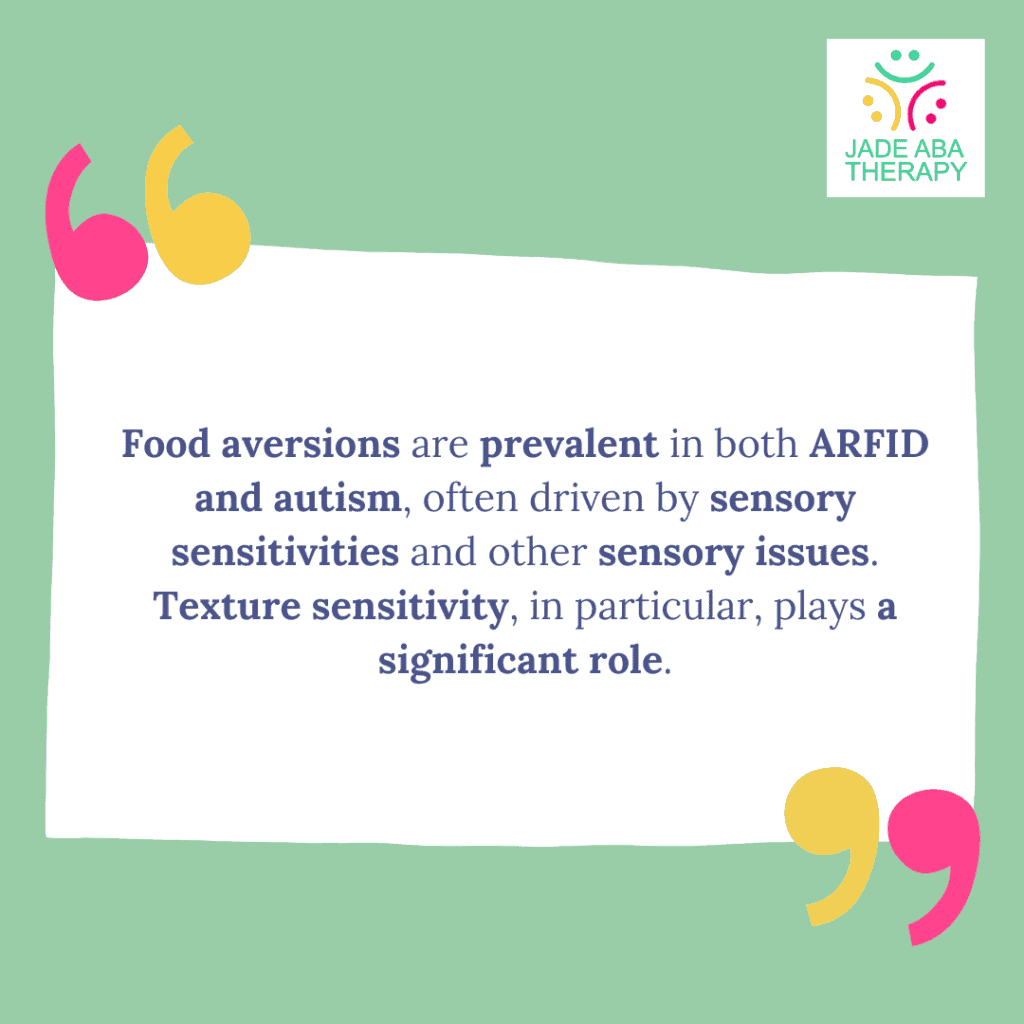Avoidant Restrictive Food Intake Disorder (ARFID) is a challenging condition that affects many children, particularly those with autism spectrum disorder (ASD). This article aims to provide parents and caregivers with a clear understanding of ARFID, its connection to autism, and effective strategies for managing this disorder.

ARFID and Autism
It’s not uncommon for autistic individuals to face challenges with eating. These challenges may stem from various factors, including sensory sensitivities towards certain foods, anxiety surrounding food, and a preference for routine and sameness.
Is ARFID common with autism?
Studies suggest that individuals with ARFID are more likely to have autism compared to those without. Although ongoing research is exploring the precise prevalence, estimates suggest that between 12.5% and 33.3% of individuals with ARFID also fall on the autism spectrum.
Unlike other eating disorders, ARFID in autism doesn’t typically involve concerns about body image or weight gain. Autistic individuals may exhibit ‘picky’ eating habits, but those with co-occurring ARFID experience more severe behaviors.
Many autistic individuals experience sensory issues, which can heighten sensitivity towards certain foods and textures, contributing to ARFID symptoms. When autism and ARFID coexist, communication challenges may exacerbate these difficulties.
On top of that, autistic individuals often exhibit a need for sameness and routine, which can extend to their eating habits. This rigidity may lead to a limited diet, with individuals preferring familiar foods to maintain comfort and predictability.
While not everyone on the autism spectrum develops ARFID, the severity of autism can influence food-related challenges. These challenges may include aversions to certain foods, fear of choking or vomiting, and reluctance to eat in social settings.
The Overlaps Between ARFID and Autism
A significant connection between ASD and ARFID lies in sensory experiences. Research indicates that children with autism often display heightened oral sensitivity, particularly oral over-sensitivity, compared to neurotypical children. Similarly, individuals with ARFID may find certain types and textures of food aversive due to oral sensations.
Another notable overlap is the pattern of sameness and rigidity observed in both conditions. Individuals with autism often demonstrate narrow interests and repetitive behaviors, which can extend to their eating habits. For instance, they may insist on consuming only specific brands of food or adhere strictly to mealtime routines.
Transitioning from one food brand to another can be distressing and overwhelming due to difficulties in set-shifting and cognitive inflexibility, characteristics commonly associated with autism. These challenges in cognitive flexibility may impede efforts to diversify the diet, affecting individuals with both autism and ARFID.
Understanding these overlaps is crucial for developing tailored interventions that address the unique needs of individuals with autism and co-occurring ARFID. By recognizing the shared characteristics and challenges, caregivers and professionals can implement strategies that support holistic well-being and foster positive relationships with food.

Helping Individuals with ARFID and Autism
Supporting individuals with ARFID and autism requires a comprehensive understanding of their unique challenges and needs. By employing a combination of therapeutic interventions and practical strategies, caregivers and professionals can help individuals overcome food aversions, improve their nutritional intake, and foster a positive relationship with food.
Addressing Food Aversions
Food aversions are prevalent in both ARFID and autism, often driven by sensory sensitivities and other sensory issues. Texture sensitivity, in particular, plays a significant role, leading individuals to avoid foods with specific textures, colors, or smells.
Fear of choking or vomiting can also contribute to food aversion, impacting mealtime behaviors. Vitamin deficiencies are a concern in both conditions due to disordered eating habits, necessitating regular monitoring to prevent serious health consequences.
Treatment Approaches
Therapeutic interventions play a crucial role in addressing ASD and ARFID. Cognitive behavioral therapy (CBT) and nutritional therapy are commonly recommended to address disruptive eating behaviors and promote healthy eating habits.
Specialized ARFID-specific CBT approaches have been developed to target the unique challenges associated with this disorder. Medications may also be considered based on individual needs, although treatment plans should be tailored to each person’s specific symptoms.
Other Practical Strategies
Several practical strategies can also help individuals with ARFID and autism overcome food aversions and improve their eating habits.
Rule out Medical Problems
Conducting thorough medical assessments, including food sensitivity testing, can uncover underlying gastrointestinal issues contributing to food aversions. For example, a child with ARFID may exhibit aversions to certain foods due to undiagnosed lactose intolerance or acid reflux. Identifying and addressing these medical issues can alleviate discomfort and improve the individual’s willingness to try new foods.
Involve the Senses
Encouraging sensory exploration can help desensitize individuals to unfamiliar food textures, smells, and tastes. For instance, a therapist working with a child with autism and ARFID might incorporate sensory play activities involving food, such as finger painting with pudding or exploring different fruits using all five senses. By gradually exposing the individual to new foods, they can become more comfortable with diverse food experiences.
Address Texture Sensitivity
Texture sensitivity is a common challenge for individuals with ARFID and autism. Caregivers can adapt food textures to accommodate these sensitivities. For example, blending vegetables into smoothies or purees, or offering crunchy alternatives like baked kale chips instead of raw vegetables, can make nutritious foods more palatable for individuals with texture aversions.
Make Eating Fun
Creating a positive mealtime environment can transform eating from a source of stress into an enjoyable experience. Parents might incorporate games, storytelling, or themed meals to make eating more engaging. For instance, turning meal preparation into a family cooking activity or arranging food in playful shapes can pique the individual’s interest and encourage participation.
Offer Choices and Control
Empowering individuals with ARFID and autism to make choices about their meals can increase their sense of autonomy. Caregivers can present a selection of nutritious options and allow the individual to choose what they want to eat. For example, a parent might offer a variety of fruits and vegetables for snacks and let the child select their favorites.
Avoid Using Food as a Reward
Using food as a reward or punishment can reinforce negative associations with eating and perpetuate unhealthy eating behaviors. Instead, caregivers can focus on non-food rewards or positive reinforcement strategies to encourage desired behaviors. For example, praising the individual for trying new foods or completing mealtime tasks can boost their confidence and motivation to explore different foods.
Practice Patience
Introducing, without a doubt, new foods can be a gradual process that requires patience and persistence. Caregivers should avoid pressuring the individual to eat unfamiliar foods and respect their pace of exploration. Celebrating small victories and acknowledging progress, such as tasting a new food or sitting at the table for a meal, can encourage continued efforts and foster a positive attitude towards eating.

The Takeaway
Eating is a routine daily event, and the difficulties associated with ARFID can create significant distress for autistic children and their families. However, with early identification, comprehensive evaluation, and consistent, evidence-based interventions, it is possible to improve food flexibility, increase oral intake, establish consistent mealtime routines, and create a positive mealtime environment.
Sources: